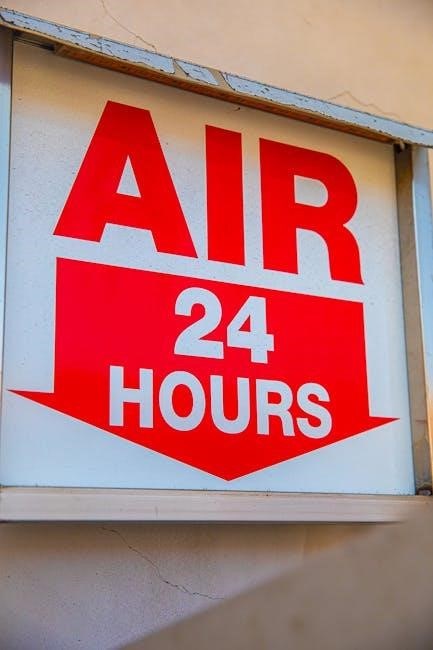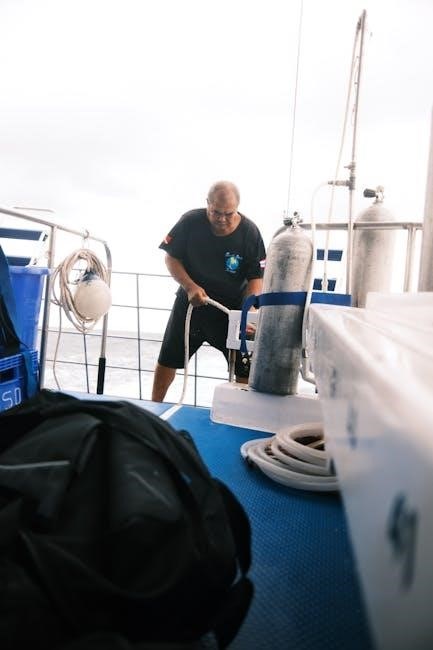A Shipper’s Letter of Instruction (SLI) is a document provided by exporters to freight forwarders, detailing shipping instructions to ensure smooth and compliant international transactions․
1․1 Definition and Purpose of the SLI
A Shipper’s Letter of Instruction (SLI) is a formal document provided by the exporter to the freight forwarder, outlining specific instructions for handling the shipment․ Its primary purpose is to ensure compliance with shipping regulations, provide detailed information about the goods, and specify the exporter’s requirements․ The SLI serves as a guide for the forwarder, covering aspects such as transportation arrangements, documentation needs, and customs compliance․ It is essential for maintaining clear communication between the shipper and the forwarder, ensuring smooth and efficient international shipping processes․
1․2 Importance of the SLI in International Shipping
The Shipper’s Letter of Instruction (SLI) is crucial for ensuring compliance with international shipping regulations and preventing delays․ It provides clarity on the shipper’s requirements, reducing misunderstandings between the shipper and freight forwarder․ The SLI ensures accurate documentation, proper customs clearance, and adherence to safety standards․ By detailing shipment specifics, it helps avoid legal or financial penalties arising from non-compliance․ Additionally, it serves as a reference for all parties involved, streamlining communication and facilitating smooth cargo movement․ Its importance lies in safeguarding the interests of both the shipper and the forwarder while ensuring efficient global trade operations․

Key Components of a Shipper’s Letter of Instruction
- Parties involved: shipper, consignee․
- Detailed description of goods․
- Shipping instructions and special requirements․
- Compliance with international regulations․
2․1 Parties to the Transaction: Shipper and Consignee
The Shipper’s Letter of Instruction (SLI) clearly identifies the parties involved in the transaction․ The shipper is the party responsible for sending the goods, while the consignee is the recipient․ Both parties’ details, including names, addresses, and contact information, must be accurately provided․ The consignee could be the buyer, a forwarding agent, or another designated party․ Ensuring the correct identification of these parties is crucial for smooth customs clearance, delivery, and legal compliance․ Any errors in this section can lead to delays or disputes․
2․2 Detailed Description of Goods
The SLI requires a precise description of the goods, including product names, quantities, weights, and dimensions․ This ensures accurate customs clearance and compliance with shipping regulations․ The description should match the commercial invoice and include Harmonized System (HS) codes for proper classification․ Packaging details, such as the number of boxes or pallets, should also be specified․ Any special markings or labels on the goods must be noted․ This level of detail prevents misunderstandings and ensures the shipment is handled correctly throughout the supply chain․
2․3 Shipping Instructions and Requirements
Shipping instructions outline the preferred transportation methods, routes, and timelines for delivery․ They specify carrier requirements, such as preferred airlines or shipping lines, and include details about loading and unloading procedures․ Special handling instructions, like temperature control or fragile item care, must also be noted․ Customs clearance instructions, including duties and taxes, should be provided to ensure smooth processing․ These instructions ensure compliance with carrier regulations and the shipper’s expectations, minimizing delays and ensuring the shipment reaches its destination efficiently and in the required condition․

How to Complete the Shipper’s Letter of Instruction
Gather all necessary details about the shipment, including shipper and consignee information, cargo specifics, and special requirements․ Follow a step-by-step approach to ensure accuracy and compliance․
3․1 Step-by-Step Guide to Filling Out the SLI
Start by gathering all necessary information, including shipper and consignee details, cargo description, and shipping requirements․ Begin with the shipper’s name, address, and contact information, followed by the consignee’s details․ Clearly describe the goods, including quantity, weight, and dimensions․ Specify shipping instructions, such as preferred transport mode, routing, and delivery terms․ Include special requirements, like handling instructions or customs documentation․ Declare hazardous goods if applicable․ Finally, review the document for accuracy, sign, and distribute copies to all relevant parties․ Ensure compliance with all regulations and standards․
3․2 Required Information for Accurate Completion
The SLI must include the shipper’s and consignee’s full details, such as names, addresses, and contact information․ A precise description of the goods is essential, covering type, quantity, weight, and dimensions․ Shipping instructions should specify transport mode, routing, and delivery terms․ Special requirements, like handling instructions for hazardous goods, must be noted․ Customs documentation, including necessary declarations, should be attached․ Additional details like insurance and packaging requirements may also be needed․ Accuracy ensures compliance and prevents delays or legal issues, making it crucial for smooth shipment processing․

The Role of the Freight Forwarder in the SLI Process
The freight forwarder acts as an intermediary, coordinating logistics, ensuring compliance, and facilitating communication between the shipper and carrier to execute the SLI effectively․
4․1 Responsibilities of the Freight Forwarder
The freight forwarder is responsible for coordinating the shipment, ensuring all details in the SLI are executed․ They handle documentation, customs clearance, and logistics, acting as a liaison between the shipper and carrier․ Freight forwarders also verify the accuracy of shipping information and ensure compliance with regulations․ Additionally, they arrange transportation, track shipments, and communicate updates to all parties involved․ Their role is critical in managing the flow of goods and meeting the specific instructions outlined in the SLI, ensuring a smooth and efficient shipping process․
4․2 Ensuring Compliance with SLI Instructions
Ensuring compliance with SLI instructions is crucial for smooth operations․ Freight forwarders must verify the accuracy of all details in the SLI, such as shipping routes, customs documentation, and packaging requirements․ They must also adhere to regulatory standards and ensure all parties comply with the instructions provided․ Proper communication and collaboration with both shippers and carriers are essential to avoid discrepancies․ By meticulously following the SLI, freight forwarders help prevent delays, legal issues, and additional costs, ensuring the shipment reaches its destination efficiently and in accordance with all specified guidelines․

Special Instructions and Additional Requirements
Special instructions may include handling hazardous goods, insurance requirements, or specific packaging needs․ Additional requirements could involve customs documentation or certifications for restricted items․
5․1 Handling Hazardous or Dangerous Goods
When shipping hazardous goods, the SLI must include specific details such as the proper shipping name, UN number, and packaging group․ The shipper must certify compliance with regulations like IATA or IMDG․ Proper documentation, including a Dangerous Goods Declaration, is required; The SLI should outline handling instructions to ensure safety during transit․ Failure to comply can result in delays or penalties․ Shippers must accurately declare hazardous goods to avoid legal and operational issues․ This ensures adherence to international safety standards and regulations․
5;2 Letter of Credit and Other Financial Requirements
The SLI must reference the Letter of Credit (L/C) or other payment terms․ It should include the L/C number, issuing bank details, and expiration date․ All financial documents, such as invoices and insurance certificates, must align with L/C conditions․ The shipper must ensure compliance with banking regulations and specify cargo insurance details․ Any discrepancies in documentation can delay payment or shipment․ Accurate financial details in the SLI are crucial for smooth transactions and maintaining trust between buyers and sellers in international trade․

Compliance and Legal Considerations
Compliance and legal considerations in an SLI ensure adherence to export controls, licensing requirements, and customs regulations, preventing legal issues and ensuring smooth international shipping operations․
6․1 Export Controls and Licensing
Export controls and licensing ensure that shipments comply with national and international regulations, restricting the export of sensitive or controlled goods․ The SLI must include details about any required licenses or permits, especially for dual-use items or goods subject to sanctions․ Non-compliance can result in legal penalties, delays, or shipment seizures․ Shippers must verify export restrictions and obtain necessary documentation before proceeding; Proper licensing ensures adherence to global trade laws, maintaining legal and ethical standards in international shipping operations․ Accurate documentation in the SLI helps avoid violations and facilitates smooth customs clearance․
6․2 Adherence to International Regulations
Adhering to international regulations is crucial for ensuring smooth and lawful global trade․ The SLI must align with standards set by organizations like the World Customs Organization and the International Chamber of Commerce․ Compliance involves accurate customs declarations, proper goods classification, and adherence to safety and environmental standards․ Non-compliance can lead to legal penalties, shipment delays, or even bans; Shippers must stay informed about changing regulations and incorporate them into their SLI to maintain compliance and avoid disruptions in the supply chain․ Proper documentation ensures that all international trade laws are respected․

Best Practices for Creating an Effective SLI
Best practices for creating an effective SLI include clear communication, precise details, using templates, thorough review, and ensuring all information aligns with shipping requirements․
7․1 Tips for Clear and Concise Communication
Clear communication is essential for an effective SLI․ Use simple, straightforward language and avoid jargon to ensure all parties understand the instructions․ Be precise with details, specifying exact quantities, dimensions, and handling requirements․ Include relevant contact information and any special instructions, such as customs documentation or packaging needs․ Avoid ambiguity by clearly stating delivery terms and expectations․ Regularly review and update the SLI to reflect current shipping requirements and avoid errors․ Consistent communication ensures smooth operations and minimizes misunderstandings throughout the shipping process․
7․2 Avoiding Common Mistakes in SLI Preparation
To avoid errors in SLI preparation, ensure all information is accurate and complete․ Double-check shipper and consignee details, as well as descriptions of goods․ Avoid omitting critical data, such as special handling instructions or customs requirements․ Be cautious of vague language, as it can lead to misinterpretation․ Verify that all dates, addresses, and contact information are correct․ Ensure compliance with regulatory requirements, such as proper declarations for hazardous goods․ Finally, review the SLI thoroughly before submission to prevent delays or legal issues․ Attention to detail is key to a smooth shipping process․

Digital Tools and Templates for SLI Creation
Digital tools and templates streamline SLI creation, enhancing efficiency and accuracy․ Software solutions offer customizable templates, auto-fill features, and real-time collaboration, simplifying the process for shippers and forwarders․
8․1 Overview of Available Templates
Various templates for the Shipper’s Letter of Instruction (SLI) are available, catering to different shipping needs․ These templates are designed to simplify the process, ensuring all critical details are included․ They often cover sections like shipper and consignee information, detailed goods descriptions, shipping instructions, and compliance requirements․ Many templates are provided by logistics companies, freight forwarders, or online platforms, offering customizable fields to adapt to specific transactions․ Using these templates helps reduce errors, saves time, and ensures adherence to international shipping standards․
8․2 Using Software for Efficient SLI Management
Modern software solutions streamline the creation and management of Shipper’s Letters of Instruction (SLIs)․ These tools offer customizable templates, automated data entry, and real-time collaboration features․ They also include validation checks to ensure accuracy and compliance with regulations․ Additionally, many platforms integrate with transportation management systems (TMS) and enterprise resource planning (ERP) software, enabling seamless communication between shippers, freight forwarders, and consignees․ This software enhances efficiency, reduces errors, and ensures that all SLI requirements are met promptly and accurately․
Common Mistakes to Avoid When Preparing an SLI
Common mistakes include inaccurate or incomplete information, such as wrong consignee details or missing shipment specifics, which can lead to delays or legal issues․
9․1 Inaccurate or Incomplete Information
Inaccurate or incomplete information in an SLI can lead to shipment delays, customs issues, or financial penalties․ Common errors include incorrect consignee addresses, missing product descriptions, or wrong shipping dates․ Shippers must ensure all details, such as HS codes, quantities, and special requirements, are accurate․ Double-checking data with the consignee and freight forwarder helps prevent errors․ Using digital templates or software can also reduce the risk of omissions, ensuring compliance and smooth processing of the shipment․
9․2 Failure to Declare Hazardous Goods
Failure to declare hazardous goods in an SLI is a serious oversight, leading to severe consequences․ Undeclared hazardous materials can cause shipment delays, fines, or even legal action․ It is the shipper’s responsibility to correctly identify and classify hazardous goods, ensuring compliance with regulations like IATA or IMDG․ Proper documentation, including Safety Data Sheets (SDS), must accompany the shipment․ Incomplete or misleading information can result in safety risks, damage to reputation, and financial losses․ Always verify hazardous goods declarations to avoid such issues and ensure smooth transportation․ Compliance is non-negotiable in international shipping․

Real-World Examples and Case Studies
A successful SLI implementation streamlined an exporter’s operations, ensuring compliance and reducing delays․ Case studies reveal challenges and lessons learned, enhancing future shipping documentation processes effectively․
10․1 Successful Implementation of SLI in Export Operations
A global electronics exporter integrated SLI into their workflow, streamlining customs clearance and reducing transit delays․ By clearly outlining shipping details, the SLI ensured compliance with export regulations and enhanced communication between the shipper and carrier․ This implementation improved order accuracy, reduced processing times, and strengthened relationships with international partners․ The SLI’s structured format also minimized errors in documentation, ensuring smooth delivery of goods․ Such success highlights the SLI’s critical role in optimizing export operations and maintaining operational efficiency․
10․2 Lessons Learned from SLI-Related Challenges
Challenges with SLIs often arise from incomplete or inaccurate information, leading to delays and compliance issues․ A common mistake is omitting critical details like proper cargo classification or special handling requirements․ Another issue is poor communication between shippers and freight forwarders, causing misunderstandings․ Lessons learned emphasize the importance of thorough reviews, clear communication, and adherence to regulatory standards․ Implementing checklist systems and training programs has helped mitigate these issues, ensuring SLIs are accurate and effective․ These insights highlight the need for precision and collaboration in SLI preparation․

Future Trends in SLI and Shipping Documentation
Digitalization and automation are transforming SLI processes, enhancing efficiency․ Blockchain technology improves security and transparency․ AI optimizes documentation, reducing errors and ensuring compliance with evolving regulations․
11․1 Digitalization and Automation of SLI Processes
Digital tools and automation are revolutionizing SLI processes, enabling shippers to streamline documentation․ Electronic data interchange (EDI) systems reduce manual errors and enhance data accuracy․ Automated templates and AI-driven platforms generate SLIs with minimal input, saving time․ Real-time tracking and notifications improve visibility throughout the shipping process․ Blockchain technology ensures secure and tamper-proof record-keeping․ These advancements not only boost operational efficiency but also ensure compliance with international regulations, making SLI preparation faster, more accurate, and less prone to human oversight․
11․2 Impact of Emerging Technologies on Shipping Documentation
Emerging technologies like AI, blockchain, and IoT are transforming shipping documentation by enhancing efficiency and transparency․ AI automates data entry and reduces errors, while blockchain provides secure, tamper-proof records․ IoT enables real-time tracking, allowing for dynamic updates to documentation․ These innovations improve accuracy, reduce fraud risks, and streamline compliance with regulations․ Additionally, big data analytics optimizes routing and predicts trends, further enhancing document precision․ Overall, these technologies make shipping processes more reliable and customer-friendly, revolutionizing how documentation is managed across the supply chain․
The Shipper’s Letter of Instruction (SLI) is a critical document in international shipping, ensuring smooth operations and compliance with regulations․ It streamlines communication between shippers, consignees, and freight forwarders, reducing errors and delays․ By providing detailed information about goods, shipping requirements, and compliance measures, the SLI acts as a cornerstone for efficient logistics․ As shipping processes evolve, understanding and effectively using the SLI will remain essential for businesses to maintain competitive and reliable global trade practices․ Continuous learning and adaptation to new standards will ensure long-term success in this dynamic industry․
